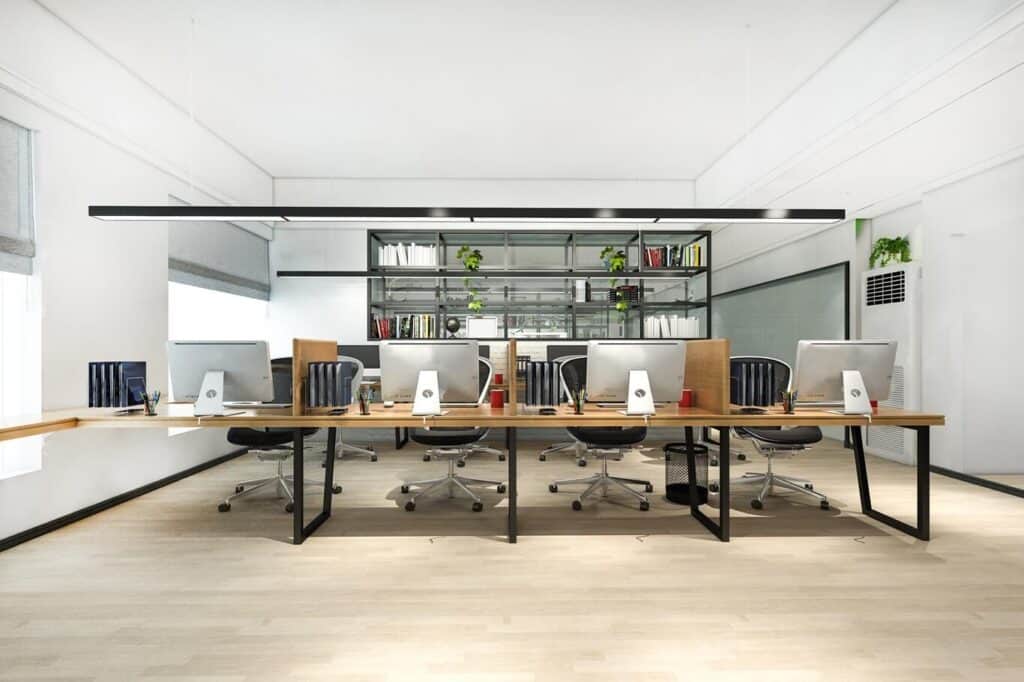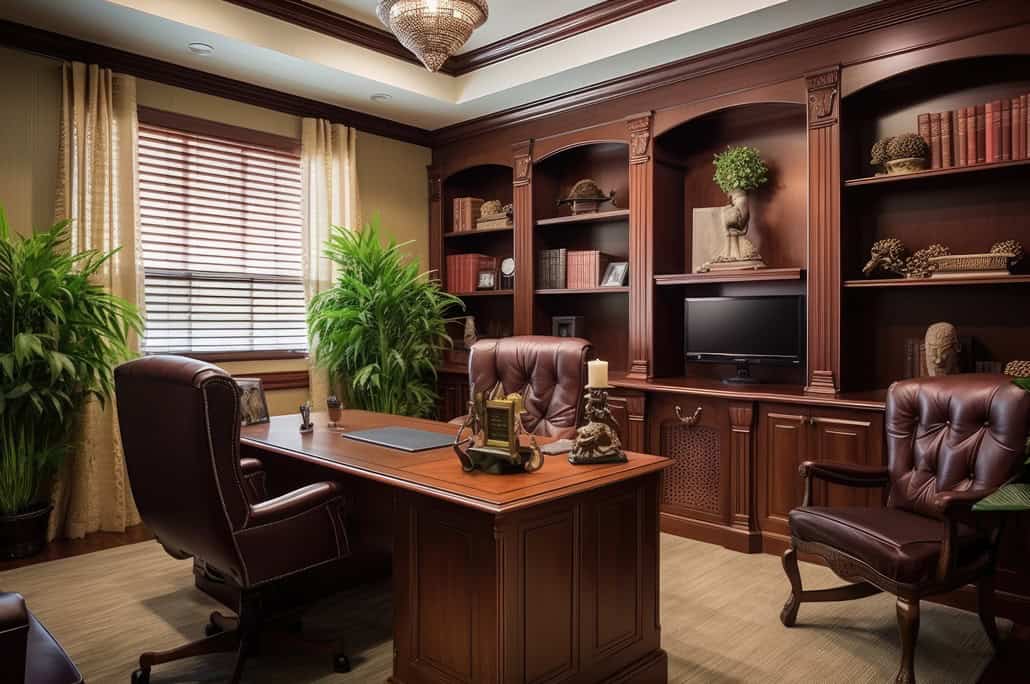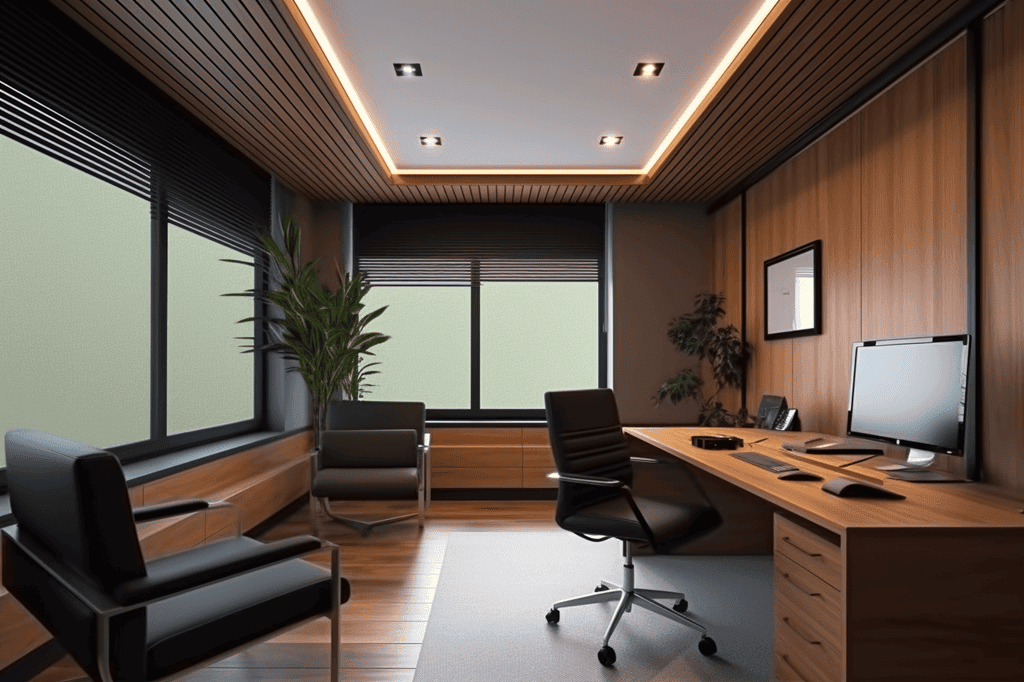Office cabin design refers to the planning, layout, and interior arrangement of individual workspaces within an office setting. It involves creating a functional and aesthetically pleasing environment that caters to the specific needs and preferences of individuals who occupy these cabins. Office cabin design takes into account factors such as space utilization, furniture arrangement, lighting, color schemes, and overall aesthetics to enhance productivity, comfort, and the overall work experience.
Here Are Examples Of Types Of Office Cabin Designs
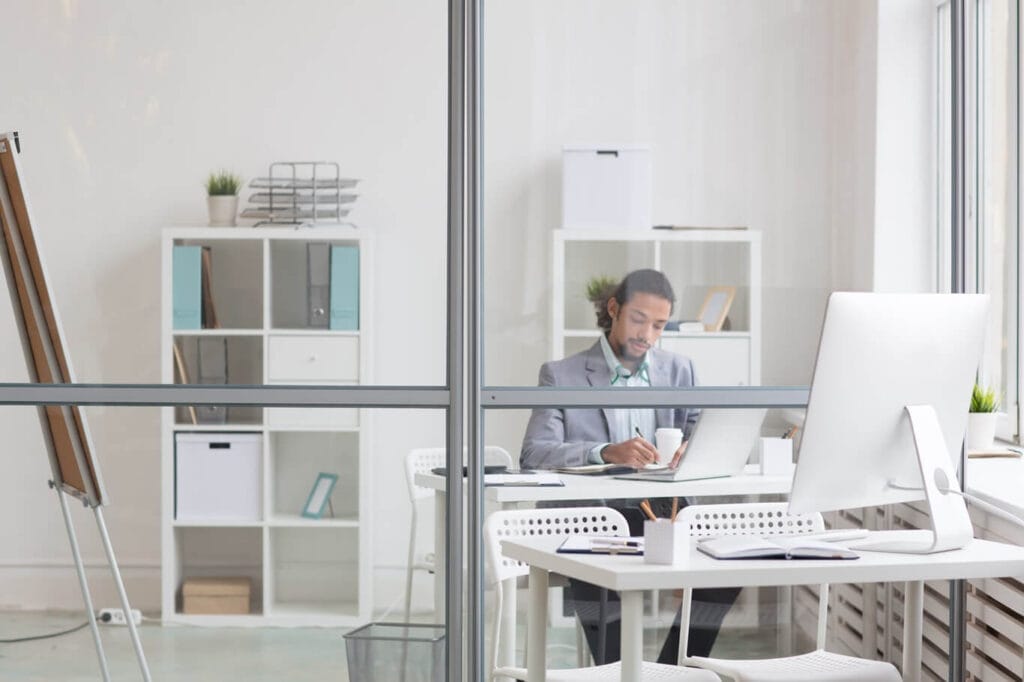
Open Concept Office Cabin Design:
- This design encourages collaboration and communication by eliminating physical barriers between workstations. It promotes a sense of openness and shared space.
Private Office Cabin Design
- This design provides enclosed and private workspaces for individuals who require a higher level of concentration and confidentiality. It often includes a dedicated desk, storage, and seating for meetings.
Cubicle Office Cabin Design
- In this design, workspaces are separated by low partitions or cubicles. It offers a balance between privacy and collaboration, creating a defined space for each employee.
Co-Working Office Cabin Design
- This design is characterized by a shared workspace where individuals from different companies or departments work in a collaborative environment. It often includes flexible seating arrangements and communal areas.
Boss office cabin design Design
- Tailored for senior executives, this design emphasizes a more spacious and luxurious office cabin. It typically includes high-quality furniture, comfortable seating, and may have additional amenities.
Hot-Desking Office Cabin Design
- In a hot-desking design, employees do not have assigned workstations. Instead, they use any available desk when they come to the office. This promotes flexibility and encourages a dynamic work environment.
Tech-Centric Office Cabin Design
- This design prioritizes the integration of advanced technologies, emphasizing features like smart lighting, interactive displays, and cutting-edge connectivity to enhance productivity and efficiency.
Minimalist Office Cabin Design
- Characterized by simplicity and a clean aesthetic, this design eliminates unnecessary clutter and decorations. It focuses on essential elements to create a streamlined and uncluttered workspace.
Each type of office cabin design serves different purposes and caters to the unique requirements of the individuals working in those spaces. The choice of design depends on factors such as company culture, the nature of work, and the preferences of employees and management.
Also Read: Innovative Ideas for Creating A Stylish Office Cabin Design
How To Do Space Planning In A Small Office Cabin Design?
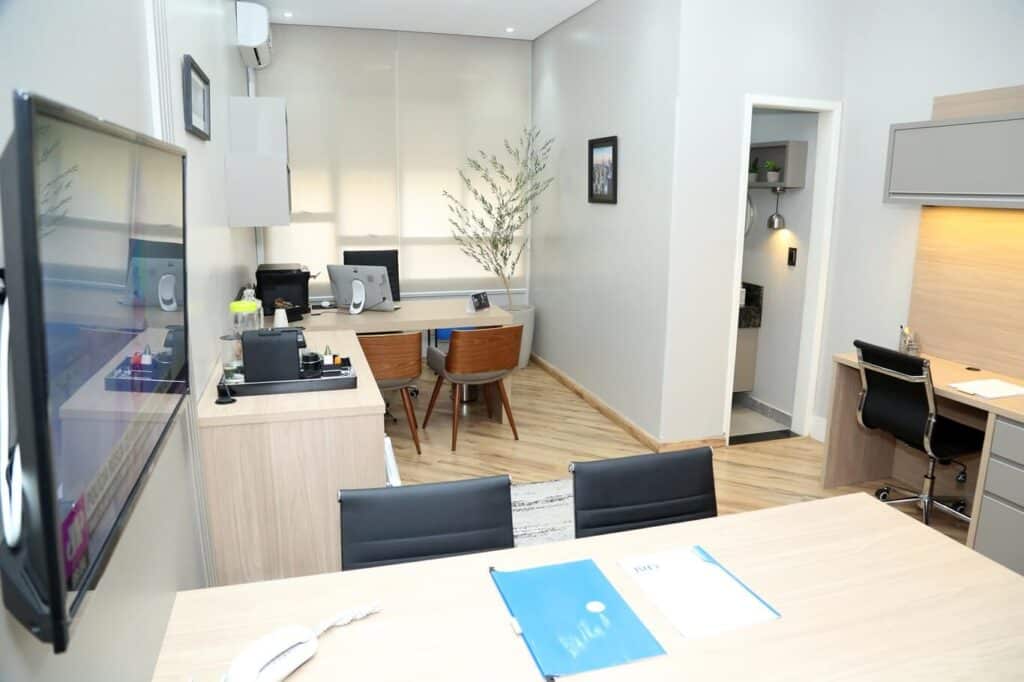
Space planning is a critical aspect of interior design that involves organizing and arranging the available space in a way that is both functional and aesthetically pleasing. In the context of a small office cabin, effective space planning is essential to maximize productivity, efficiency, and comfort. Here’s a detailed explanation of key aspects of space planning:
Define the Purpose
- Clearly understand the intended use of the space. Identify specific functions that need to be accommodated, such as workstations, storage, meeting areas, and circulation paths.
Traffic Flow
- Establish clear pathways and circulation routes. Ensure that there are no obstacles or hindrances to movement within the space. Consider the natural flow of people as they enter, move through, and exit the office cabin.
Zoning
- Divide the space into functional zones based on activities. Common zones in a small office cabin may include work areas, meeting spaces, and storage. Clearly delineate these zones through the arrangement of furniture and other elements.
Furniture Placement
- Choose appropriately sized furniture to prevent overcrowding. Consider the scale of the furniture in relation to the size of the room. Arrange furniture to create a balanced and harmonious layout.
- Ensure that desks and workstations are positioned to facilitate collaboration while maintaining individual workspaces. Consider the ergonomic placement of chairs and desks to promote comfort and productivity.
Multipurpose Spaces
- Optimize the use of space by incorporating multipurpose furniture and flexible layouts. For example, a meeting table could also serve as a workspace, and movable partitions might create a temporary meeting area.
Vertical Space Utilization
- Make use of vertical space for storage and organization. Install shelving units, cabinets, or wall-mounted storage to keep the floor clear and maximize storage capacity.
Natural Light Considerations
- Take advantage of natural light sources by placing workstations and common areas near windows. Ensure that the arrangement of furniture does not obstruct natural light, helping to create a more open and inviting atmosphere.
Focal Points
- Create focal points within the office cabin to draw attention and anchor the design. This could be a statement piece of furniture, artwork, or a well-designed collaborative space.
Color and Material Selection
- Choose colors and materials that contribute to a visually cohesive and harmonious environment. Light and neutral colors can make a small space feel larger, while reflective surfaces can enhance brightness.
Also Read: How To Choose The Best Interior For Your Office Cabin Design
Best Types Of Lighting For A Small Office Cabin Design?
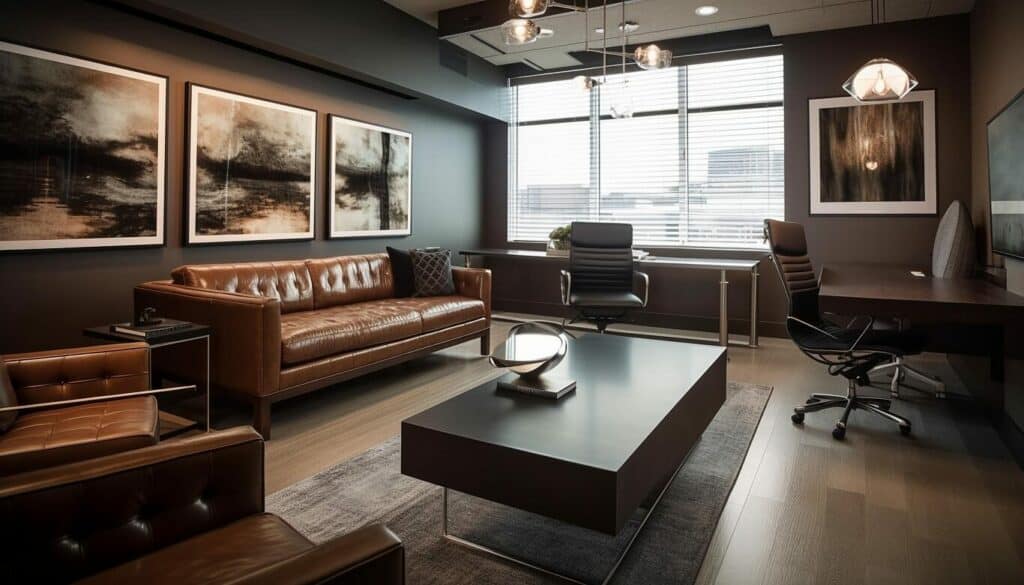
Lighting is a crucial aspect of any interior design, and in a small office cabin, it becomes even more essential to create a comfortable and productive environment. Here’s a detailed explanation of various aspects of lighting in a small office cabin:
Natural Lighting
- Orientation of Windows: Consider the placement and orientation of windows to maximize the entry of natural light. North-facing windows provide consistent, diffused light while south-facing windows offer brighter, direct sunlight.
- Window Treatments: Use adjustable window treatments like blinds or sheer curtains to control the amount of natural light entering the space while maintaining privacy.
Artificial Lighting
- Task Lighting: Install task lighting in specific work areas, such as desk lamps or under-cabinet lights. This provides focused illumination for tasks like reading, writing, or using a computer.
- Ambient Lighting: Use ambient lighting, such as ceiling fixtures or wall sconces, to create a general, comfortable level of illumination throughout the space.
- Accent Lighting: Highlight specific areas or features with accent lighting. This could include track lighting, wall-mounted spotlights, or LED strips to add visual interest.
Color Temperature
- Warm vs. Cool Lighting: Consider the color temperature of light sources. Warmer tones (around 2700-3000K) create a cozy and inviting atmosphere, while cooler tones (4000K and above) can promote alertness and concentration.
Layered Lighting
- Task, Ambient, and Accent Layers: Incorporate a combination of lighting layers. Task lighting for functionality, ambient lighting for overall illumination, and accent lighting for aesthetics. This allows for flexibility and control over the lighting atmosphere.
Control Systems
- Dimmers: Install dimmer switches to adjust the intensity of the lighting, allowing for different moods and tasks throughout the day.
- Smart Lighting: Consider smart lighting systems that enable remote control or automation, allowing for easy adjustment of lighting levels.
Lighting Fixtures
- Fixture Styles: Choose fixtures that complement the overall design theme. Sleek, modern fixtures can enhance a contemporary design, while traditional fixtures may suit a more classic aesthetic.
- Fixture Placement: Ensure even distribution of light by strategically placing fixtures. Avoid creating shadows or dark corners.
Lighting for Different Zones
- Work Areas: Focus on providing ample task lighting for desks and workstations to reduce eye strain.
- Collaborative Areas: Ensure well-distributed ambient lighting in areas where collaborative work or meetings take place.
- Reception/Waiting Areas: Use welcoming ambient lighting to create a comfortable environment for visitors.
Energy Efficiency
- LED Lighting: Consider using energy-efficient LED lighting, which not only reduces energy consumption but also produces less heat, making the workspace more comfortable.
- Occupancy Sensors: Install occupancy sensors to automatically turn off lights in unoccupied areas, promoting energy savings.
By paying attention to these details, you can create a well-lit small office cabin that promotes productivity, comfort, and a visually appealing environment for its occupants.
Also Read: Transforming Spaces with Captivating Office Cabin Designs
You Can Create Office Cabin Design with Officebanao
If you want to transform your office into a luxury modern office design, you can rely on Officebanao’s office interior design. They are the best office interior design services company.
We have developed our own technology and gained extensive experience in creating contemporary and creative office reception design. Our focus is on providing tailor-made solutions that match your brand identity and business goals as it is the office interior design in India.

